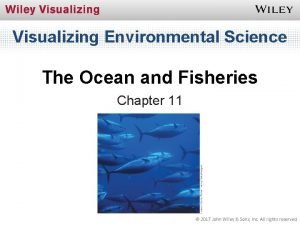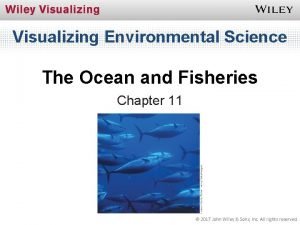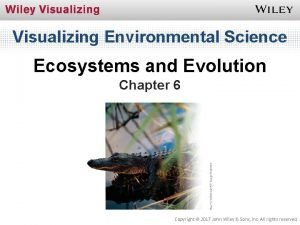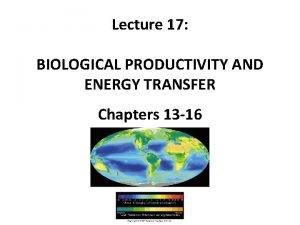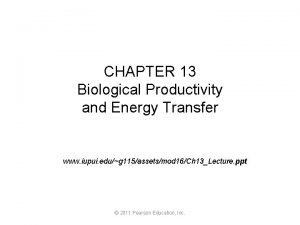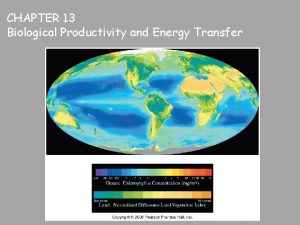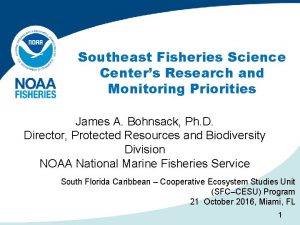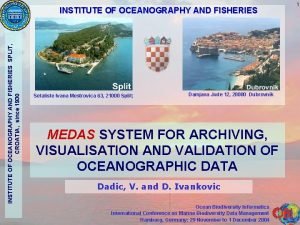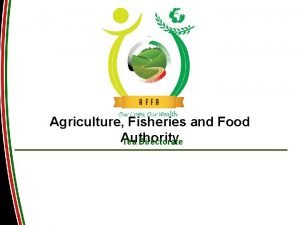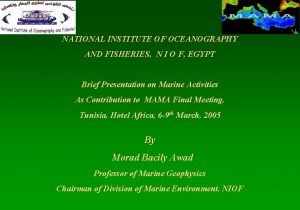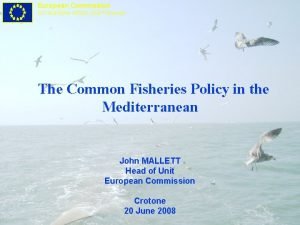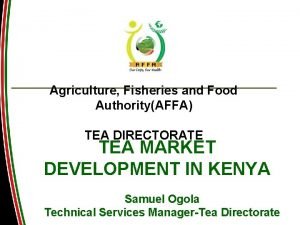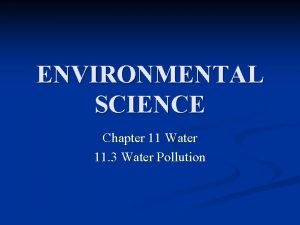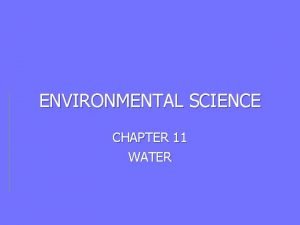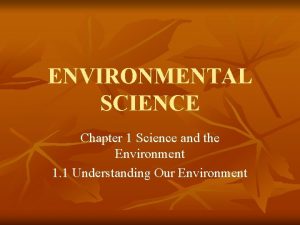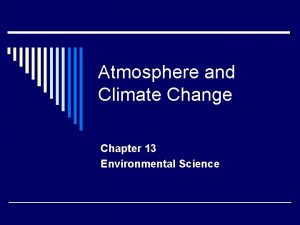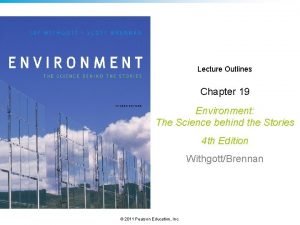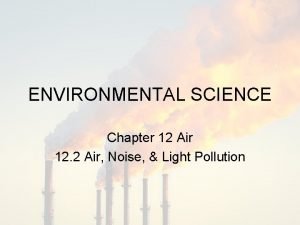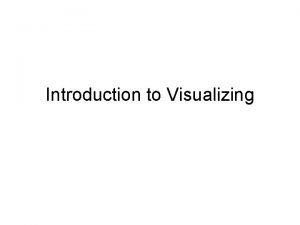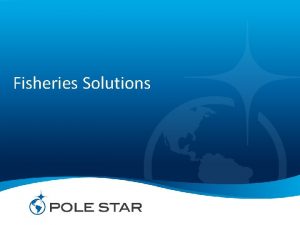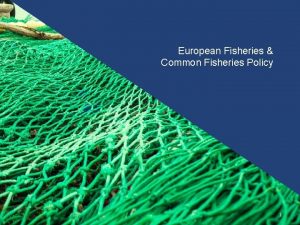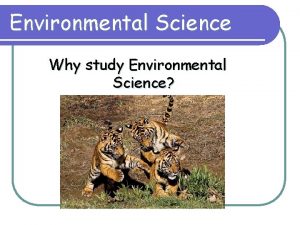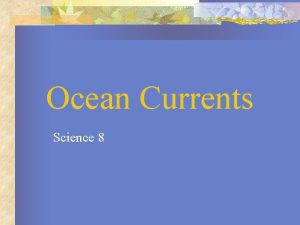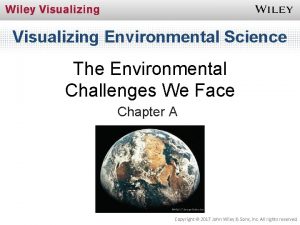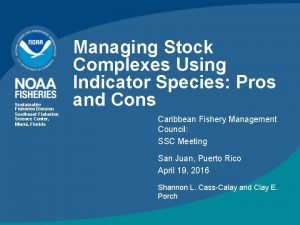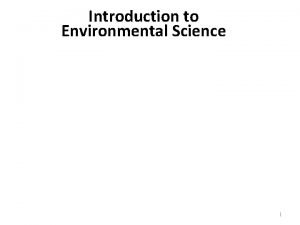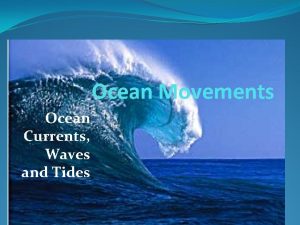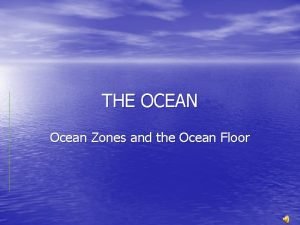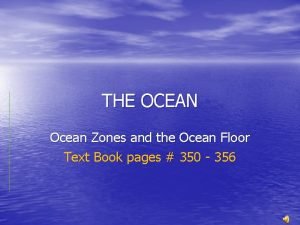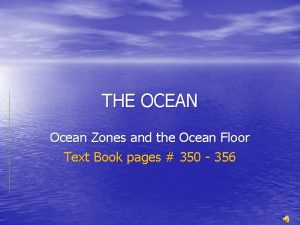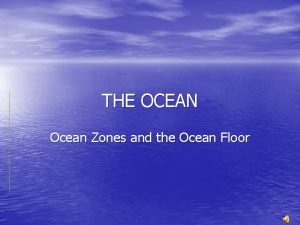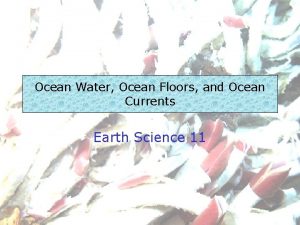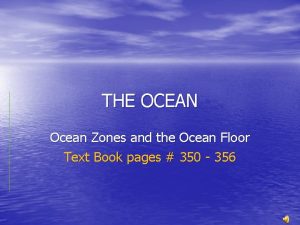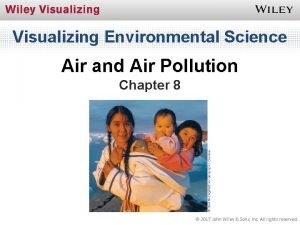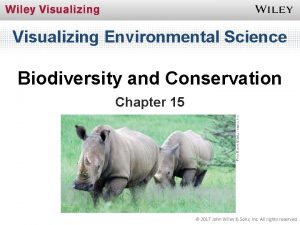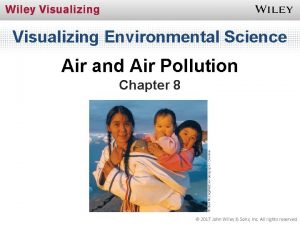Visualizing Environmental Science The Ocean and Fisheries Chapter






























- Slides: 30

Visualizing Environmental Science The Ocean and Fisheries Chapter 11 © 2017 John Wiley & Sons, Inc. All rights reserved.

The Global Ocean • Huge body of water – Surrounds continents – Covers ___ of world’s surface – Single continuous body of ______ • Four sections separated by continents – Pacific, Atlantic, Indian and Arctic oceans – The Pacific is the _______, covering 1/3 of the Earth’s surface and containing more than half of Earth’s water © 2017 John Wiley & Sons, Inc. All rights reserved.

Ocean-Atmosphere Interaction • Wind from atmosphere affects ocean ______ • Heat from ocean affects atmospheric circulation • ______-Southern Oscillation (ENSO) – A periodic, large-scale warming of surface waters of the tropical eastern Pacific Ocean that temporarily alters both ______ and atmospheric circulation patterns – Responsible for world’s interannual climate variability – Ocean currents slow down or _____; this is known as El Niño © 2017 John Wiley & Sons, Inc. All rights reserved.

Normal vs. El Niño (ENSO) Conditions © 2017 John Wiley & Sons, Inc. All rights reserved.

Ocean-Atmosphere Interaction • La Niña – Often occurs after _____ event – More difficult to predict effects – Typically causes • Wetter than usual ______ in Pacific Northwest • Warmer weather in Southwest • Atlantic hurricanes are _____ and more numerous © 2017 John Wiley & Sons, Inc. All rights reserved.

Human Impacts on the Ocean • Fisheries and __________, marine shipping, marine pollution, coastal development, offshore mining, and global ______ change, all contribute to marine environment degradation • Paradox: ocean provides food but is used as _______ ground – Pollution increasingly threatens the world’s fisheries – 80% of ocean pollution comes from _______ activities on land

Problems and Challenges for the Fishing Industry • World’s annual fish harvest – 1950 - 19 million tons – 2000 - 95 million tons – 2012 - ____ million tons • No nation has legal claim to the open ocean – Resources are susceptible to overuse and degradation – Many species have been harvested to the point where their _________ are severely depleted • Many nations have extended their limits of jurisdiction to 320 km (200 mi) offshore, to prevent __________ © 2017 John Wiley & Sons, Inc. All rights reserved.

Problems and Challenges for the Fishing Industry • At least 30% of world’s fish stocks are __________, and 57% are fully exploited – Growing human population requires protein – _______ (the fishes, marine mammals, sea turtles, seabirds, and other animals caught unintentionally in a commercial fishing catch) exceeds 7. 7 million tons annually • Modern _________ fishing methods have led to the collapse of formerly productive fisheries due to overfishing – Drift _____, trawls, purse seines, and longlines are so efficient that they can depopulate a fishery past the point of recovery © 2017 John Wiley & Sons, Inc. All rights reserved.

Aquaculture: Fish Farming • ____________ – Fish farming: Growing of aquatic organisms for human consumption • Developing nations produce more _________ from aquaculture than they harvest from the ocean • Fish farms have dense populations – Lots of polluting _______ – Cause net loss of wild fish (raised fish tend to be carnivorous) – Ocean ranching: Deep-water, off-shore aquaculture • Doesn’t harm coastline, but less oversight to prevent pollution • Risk of reduced _______________ in wild fish populations due to interbreeding with farmed fish © 2017 John Wiley & Sons, Inc. All rights reserved.

Shipping, Ocean Dumping, and Plastic Debris • Millions of ships dump _______ ballast and waste • Ocean Dumping Ban Act – 1991 • Cities used to dump _______ into ocean, disease-causing organisms contaminated shellfish • ________ waste • Doesn’t degrade, just breaks up into smaller pieces • Eastern Pacific garbage patch covers very large area in the North Pacific gyre • Plastic pieces ________ marine mammals and birds • Filter feeders ingest plastic pieces, carriers of PCBs © 2017 John Wiley & Sons, Inc. All rights reserved.

Coastal Development • Alters or ________ coastal ecosystems – Mangroves, salt marshes, sea grass beds, coral reefs • Coastal areas are overdeveloped, highly _________, overfished • Coastal management plans are inadequate – Biggest problem is human _________ size – ______ of world’s population lives within 150 km (93 mi) of coastline

Human Impacts on Coral Reefs • ______ formations are important ecosystems, and they are being degraded and destroyed – Silt washing downstream from clear-cut forests is smothering reefs – __________ = stressed corals expel zooxanthellae; correlated with warming ocean waters and increased dissolved ______ levels – High salinity from freshwater diversion projects – Overfishing of top __________ – Pollution from ocean dumping and coastal pollution © 2017 John Wiley & Sons, Inc. All rights reserved.

Climate Change, Sea-Level Rise, and Warmer Ocean Temperatures • The ocean is ______ along with global climate, but it is difficult to accurately predict all future consequences –Rise in sea levels due to _______ melting is already occurring • Coastal flooding, wetlands loss, flooding risks, and saltwater ______ possible Annual global mean temperature changes of the ocean surface © 2017 John Wiley & Sons, Inc. All rights reserved.

Visualizing Environmental Science Agriculture and Food Resources Chapter 14 Copyright © 2017 John Wiley & Sons, Inc. All rights reserved.

World Food Problems • Undernutrition: Type of malnutrition in which there is underconsumption of _______ or nutrients that leaves the body weakened and susceptible to disease —Even if receiving enough calories, __________ happens if not enough essential nutrients (protein, ________, minerals) are present in Most of the world's undernourished people live in Asia and sub-Saharan Africa. Copyright © 2017 John Wiley & Sons, Inc. All rights reserved. the diet

World Food Problems • ____________: Amount of food consumed exceeds necessary calories or essential nutrients —Usually from diets high in saturated fats, _______, and salt —Results in high blood pressure, obesity, and increased likelihood of ________, heart disease, etc. —Most common in the _________ and other highly developed nations, and in urban areas of developing nations

Poverty and Food • Main cause of undernutrition and food insecurity is ________ • Solutions – Increase ________ production of food – Improve food distribution – Promote economic development – Ensure education and opportunities for _______ and small scale farmers, who produce significant amounts of basic _______ in some regions Copyright © 2017 John Wiley & Sons, Inc. All rights reserved.

The Principal Types of Agriculture • Industrialized agriculture – Utilized in ________ developed and some developing countries – High-input: Requires large capital and _____ inputs, less land, and less manual labor than traditional methods • Significantly dependent on ________ • Produces ____ yields • Monoculture cultivation predominates • Soil degradation, pesticide resistance common Copyright © 2017 John Wiley & Sons, Inc. All rights reserved.

The Principal Types of Agriculture • __________ agriculture – Utilized by most farmers in most developing countries – Traditional agricultural methods that depend on _____ and a large amount of land • Just enough food to feed farmer and family – Cultivation methods vary depending on area • Shifting cultivation • ____________ agriculture • Nomadic herding • Intercropping • __________ Copyright © 2017 John Wiley & Sons, Inc. All rights reserved.

Challenges of Producing More Crops and Livestock • Challenges • Decline in __________ • Declining numbers of domesticated varieties • Continuing to improve crop and livestock yields • Addressing ____________ impacts – Agribusiness conglomerates are replacing the ______ farm • ______ of urbanization, suburban sprawl – Parking lots, housing developments, shopping malls Copyright © 2017 John Wiley & Sons, Inc. All rights reserved.

Increasing Crop Yields • _______________ – By the 1960 s, the combination of selective breeding and pesticide and ________ use led to significantly increased crop yields around the world. – Some drawbacks: • High ________ and infrastructure costs • Environmental costs of high fertilizer and pesticide use • Loss of local varieties with important ________ characteristics useful for their regions Copyright © 2017 John Wiley & Sons, Inc. All rights reserved.

Increasing Livestock Yields • Hormones promote _______ growth • Fear that hormones may affect child development, promote _______ • Antibiotics improve livestock weight gain, less ________ – Indiscriminate use leads to development of resistant strains of bacteria—reduces antibiotic efficacy in ______

Genetic Modification • Genetic engineering • Manipulation of genes to produce a particular trait – ___________ – Has the potential to produce genetically _______ (GM) plants that can be: • More _________ food plants that contain all essential amino acids or that would be rich in vitamins • Resistant to viral diseases, drought, heat, cold, herbicides, ________, insect pests, etc. Copyright © 2017 John Wiley & Sons, Inc. All rights reserved.

Genetic Modification • Concerns about genetically modified foods – ______ of inserted genes to weeds or nonrelated crops – Potential for food ______ development in some consumers – Non-GM farmers may lose genetic integrity of crops due to ____ pollen transfer

Environmental Impacts • Industrialized agriculture has many environmental ______ – Increased carbon footprint – Water _________ • Animal wastes, fertilizers, and pesticides, are an important cause of surface water pollution – _______ pollution • Due to agricultural use of fossil fuels, pesticides, fertilizers • Impacts of industrialized agriculture: – __________ (toxic chemicals used to kill pests) resistance and residues Copyright © 2017 John Wiley & Sons, Inc. All rights reserved.

Environmental Impacts • Impacts of industrialized agriculture: – _____ degradation • Reduction in the potential ability of the land to support crops/livestock • ___________, compaction, salinization – Habitat fragmentation • Breakup of large areas of habitat into ______, isolated patches • Many species are __________ due to habitat loss to agriculture Copyright © 2017 John Wiley & Sons, Inc. All rights reserved.

Moving to Sustainable Agriculture • Food production in its current state may not be __________ • Sustainable agriculture combines ______ with traditional techniques – Diversification of crops and livestock – Breeding of disease _________ varieties – Water and energy conservation – Crop rotation, _______ farming to preserve soil quality (No-till farming involves planting crops over the previous dead crops without disturbing the soil) – Pesticides which are used should disintegrate rapidly and not persist in the environment Copyright © 2017 John Wiley & Sons, Inc. All rights reserved.

Controlling Agricultural Pests • Pest – Any organism that ________ in some way with human welfare or activity • __________ – The agent used to reduce pest populations – Can be grouped by target organisms • Insecticides • _________ • Rodenticides • Fungicides Copyright © 2017 John Wiley & Sons, Inc. All rights reserved.

Benefits of Pesticides • Effectively control organisms that spread disease • Protect _____ from pests and pathogens – 1/3 of crops are destroyed by pests • _________ (single species grown in large areas) amplify effect of pests • Genetic resistance – In the 60 years of wide pesticide use, at least 520 species of insects and mites and at least ______ plant species have evolved genetic _______ to certain pesticides Copyright © 2017 John Wiley & Sons, Inc. All rights reserved.

Case Study • Organic agriculture – No use of commercial inorganic fertilizers or _________ – Organic Food Production Act of 1990 • Specifies ________ for organic production and labeling • Federal standards for organic certification went into effect in _____ – In 2011, 2 million hectares farmed organically in the U. S. – Rapid growth in organic agriculture in U. S. today • U. S. sales of organic products increased from $3 billion in 2008 to $ ____ billion in 2014 Copyright © 2017 John Wiley & Sons, Inc. All rights reserved.
 Visualizing environmental science solution manual
Visualizing environmental science solution manual Visualizing environmental science solution manual
Visualizing environmental science solution manual Visualizing environmental science (doc or html) file
Visualizing environmental science (doc or html) file Ocean fisheries
Ocean fisheries Ocean fisheries
Ocean fisheries Ocean fisheries
Ocean fisheries Chapter 15 ocean water and ocean life answer key
Chapter 15 ocean water and ocean life answer key Southeast fisheries science center
Southeast fisheries science center Rule of 70 population growth
Rule of 70 population growth Convergent boundary
Convergent boundary Ocean ocean convergent boundary
Ocean ocean convergent boundary Convergent boundary
Convergent boundary Ocean ocean convergent boundary
Ocean ocean convergent boundary Seafloor spreading demonstration
Seafloor spreading demonstration Convergent oceanic oceanic plate boundary
Convergent oceanic oceanic plate boundary Blue ocean strategy canvas
Blue ocean strategy canvas Split institute of oceanography and fisheries
Split institute of oceanography and fisheries Agriculture fisheries and food authority
Agriculture fisheries and food authority Institute of oceanography and fisheries
Institute of oceanography and fisheries Ministry of food agriculture and fisheries denmark
Ministry of food agriculture and fisheries denmark Rules of natural justice
Rules of natural justice Dg maritime affairs and fisheries
Dg maritime affairs and fisheries Tea directorate
Tea directorate My favourite subject is biology
My favourite subject is biology Objectives of water pollution
Objectives of water pollution Water that contains waste from homes or industry.
Water that contains waste from homes or industry. Environmental science chapter
Environmental science chapter Chapter 13 environmental science
Chapter 13 environmental science Chapter 19 environmental science
Chapter 19 environmental science Chapter 2 economics and environmental policy
Chapter 2 economics and environmental policy Chapter 12 environmental science
Chapter 12 environmental science
